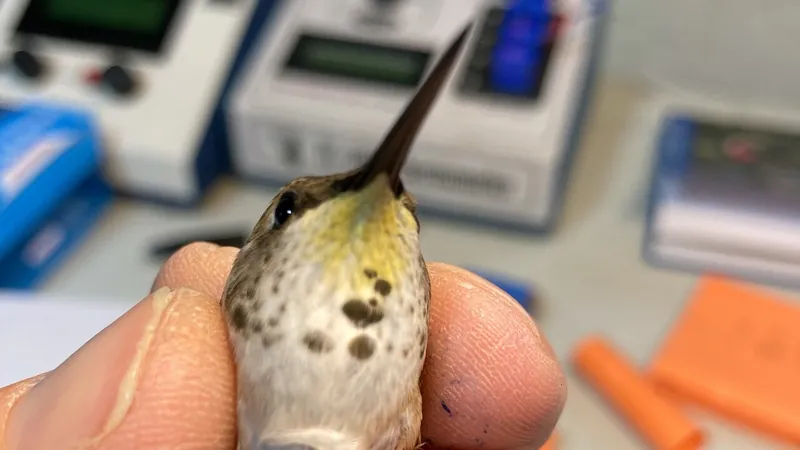
Unveiling the Secrets of Hummingbird Torpor: Nature’s Ingenious Survival Strategy
2025-01-16
Author: Nur
Introduction
Hummingbirds, those tiny marvels of the avian world, demonstrate remarkable resilience despite their diminutive size. These fascinating creatures embark on astonishing migrations, sometimes spanning over 9,000 kilometers (around 5,590 miles) annually. Their energy-intensive journeys are primarily fueled by nectar, which they extract from flowers and convert into essential fat reserves.
The Challenge of Climate Change
However, our climate is changing rapidly, and land use is shifting, disrupting the distribution of wildflowers that are vital for these migratory birds. To navigate the unpredictable scarcity of food sources, hummingbirds employ a fascinating survival mechanism known as torpor—an incredibly efficient form of overnight hibernation.
Recent Research on Torpor
Recent research led by Shayne R. Halter, a Ph.D. candidate at The University of New Mexico Department of Biology, sheds light on this critical survival strategy. In a groundbreaking study titled "The hummingbird's adipostat: can a simple rule explain torpor frequency and duration in hummingbirds?" published in *Proceedings of The Royal Society B: Biological Sciences*, Halter and his team offer new insights into how these feathered athletes manage their energy reserves during migration.
Focus on Calliope and Rufous Hummingbirds
The study focuses specifically on the Calliope (Selasphorus calliope) and Rufous (Selasphorus rufus) hummingbirds, observed along the Mimbres River in New Mexico. As climate change continues to make the distribution of food unpredictable, Halter's findings reveal that these birds manipulate torpor to ensure they wake up each day with just enough fat reserve to survive amid uncertainty.
Understanding Torpor
Torpor involves a significant drop in a bird's metabolic rate and body temperature, typically lasting several hours. While similar to hibernation, torpor distinguishes itself by occurring over a much shorter timeframe. Halter's research has determined that hummingbirds enter this state only when their body fat dips below a critical level, thus balancing their energy needs with environmental risks such as predation.
Key Findings
"To thrive, hummingbirds must maintain a minimum fat reserve," Halter explains. "In our findings, we’ve identified that torpor manifests when evening fat levels drop below 500 milligrams, necessitating a morning reserve of approximately 180 milligrams to sustain their day until the next feeding opportunity."
Implications for Conservation
The implications of this research are staggering, particularly when considering the increasing challenges that hummingbirds face each migration season. The rise of warmer and drier conditions in the arid southwestern U.S. is already impacting the availability of nectar sources, ultimately influencing the timing of migration. Moreover, land-use changes are replacing native flora with non-nectar producing species, exacerbating the food scarcity.
Conclusion
As we witness the realities of climate change taking shape in our ecosystems, the ability of hummingbirds to adapt through mechanisms like torpor highlights both the tenacity of nature and the urgent need for conservation efforts. Protecting their habitats and food sources not only supports these remarkable creatures but also preserves the delicate balance of our natural world. Are we ready to take a stand for these tiny giants of migration? The fate of hummingbirds—and countless other species—depends on it!



 Brasil (PT)
Brasil (PT)
 Canada (EN)
Canada (EN)
 Chile (ES)
Chile (ES)
 Česko (CS)
Česko (CS)
 대한민국 (KO)
대한민국 (KO)
 España (ES)
España (ES)
 France (FR)
France (FR)
 Hong Kong (EN)
Hong Kong (EN)
 Italia (IT)
Italia (IT)
 日本 (JA)
日本 (JA)
 Magyarország (HU)
Magyarország (HU)
 Norge (NO)
Norge (NO)
 Polska (PL)
Polska (PL)
 Schweiz (DE)
Schweiz (DE)
 Singapore (EN)
Singapore (EN)
 Sverige (SV)
Sverige (SV)
 Suomi (FI)
Suomi (FI)
 Türkiye (TR)
Türkiye (TR)
 الإمارات العربية المتحدة (AR)
الإمارات العربية المتحدة (AR)